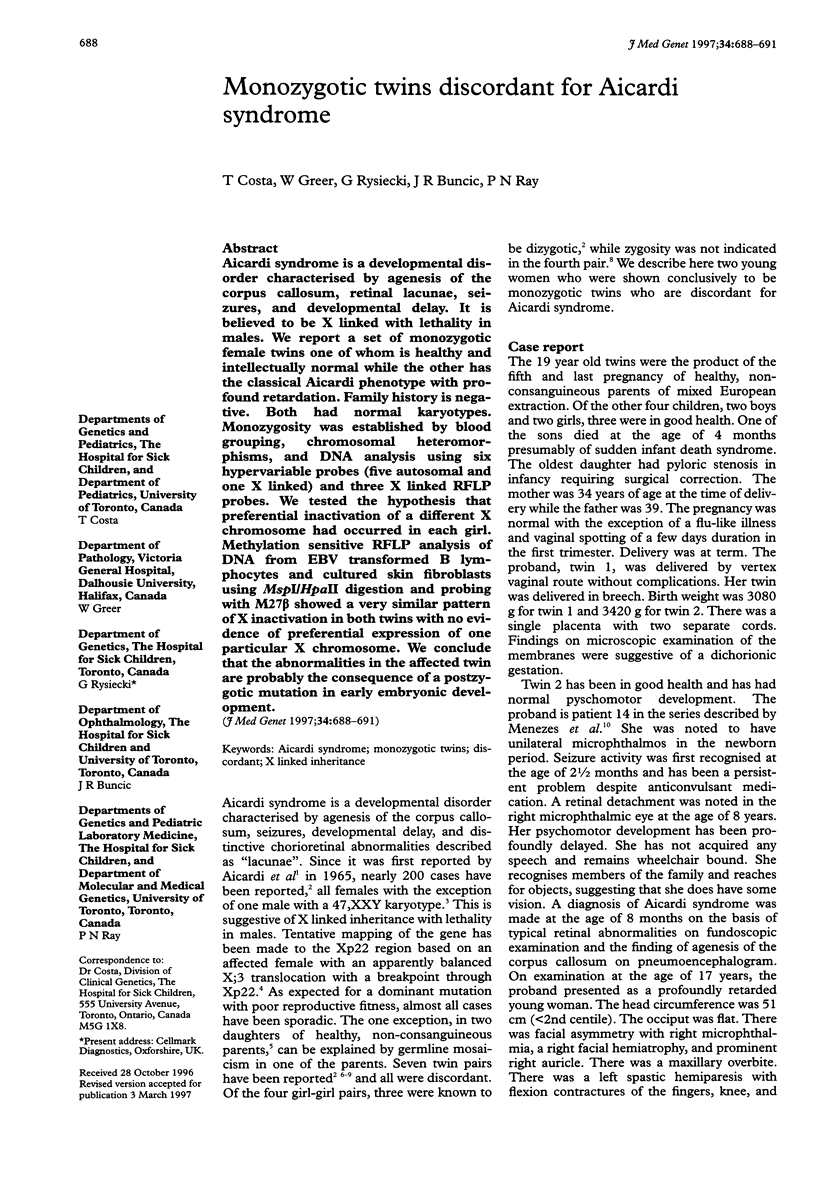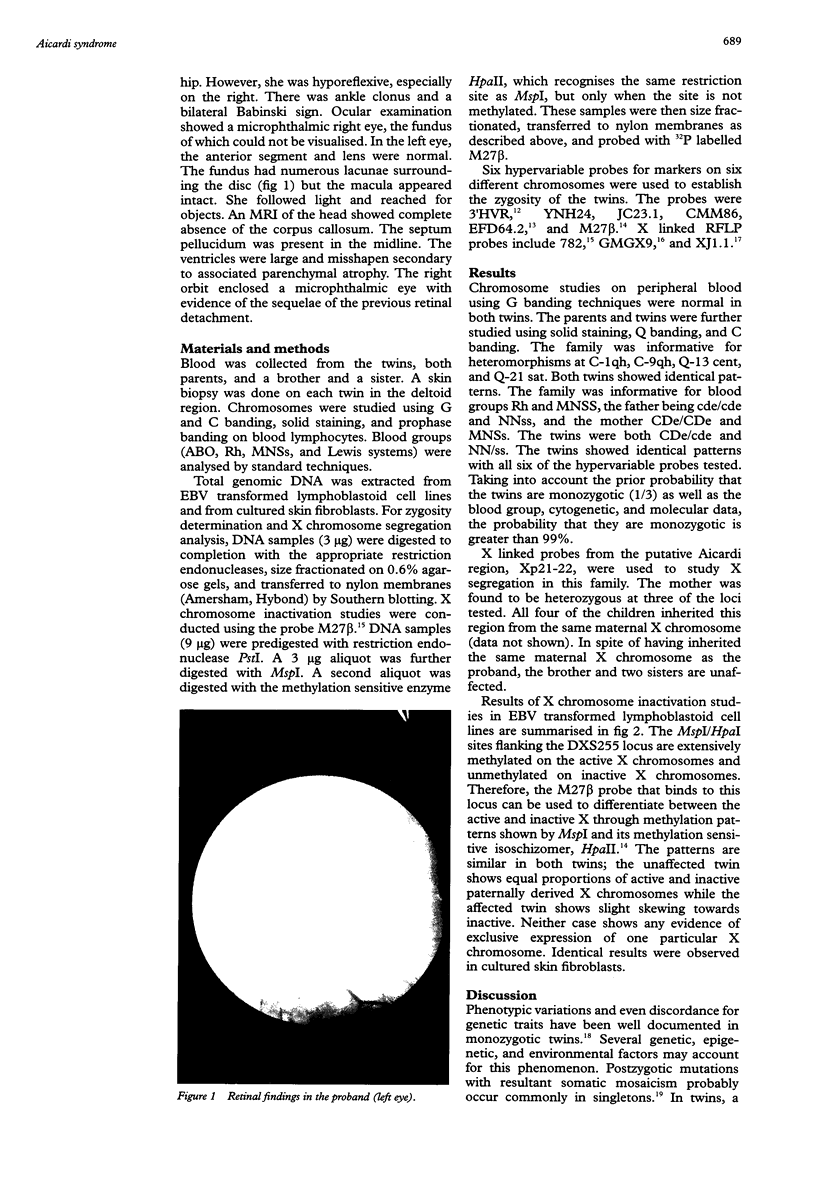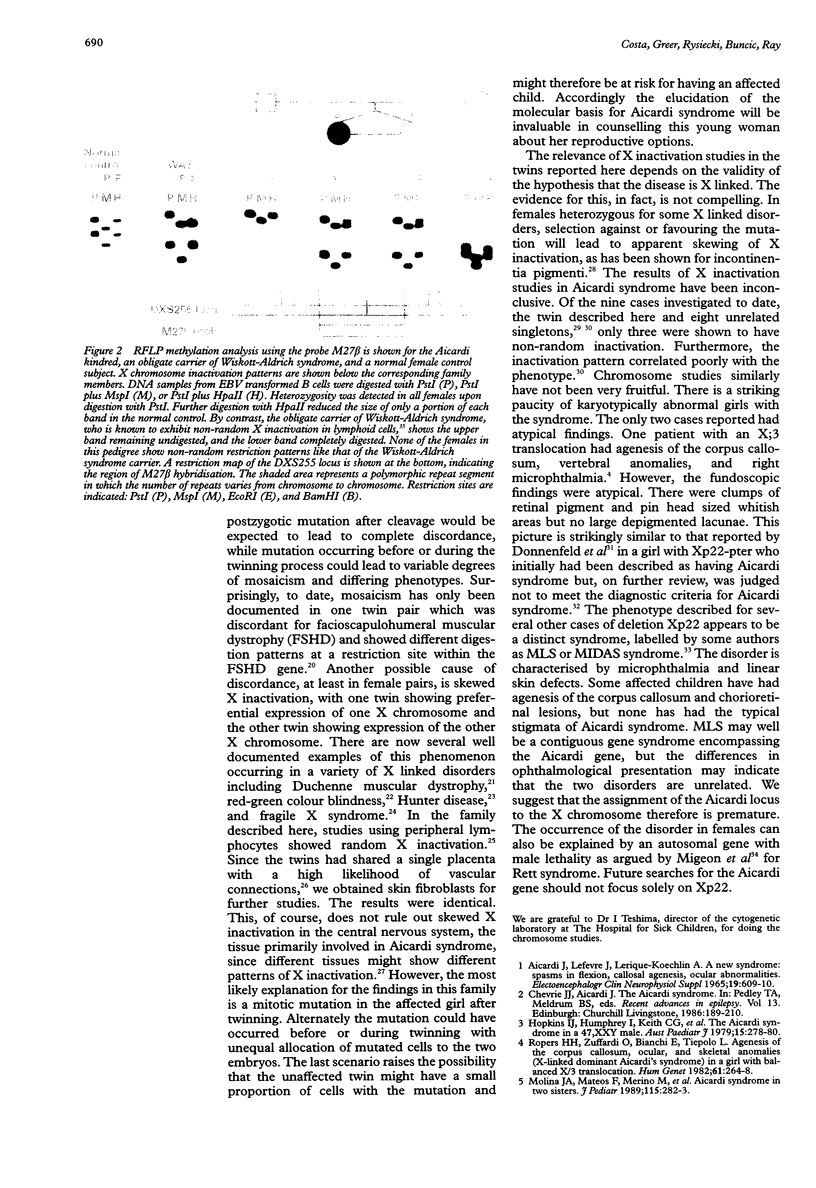Abstract
Aicardi syndrome is a developmental disorder characterised by agenesis of the corpus callosum, retinal lacunae, seizures, and developmental delay. It is believed to be X linked with lethality in males. We report a set of monozygotic female twins one of whom is healthy and intellectually normal while the other has the classical Aicardi phenotype with profound retardation. Family history is negative. Both had normal karyotypes. Monozygosity was established by blood grouping, chromosomal heteromorphisms, and DNA analysis using six hypervariable probes (five autosomal and one X linked) and three X linked RFLP probes. We tested the hypothesis that preferential inactivation of a different X chromosome had occurred in each girl. Methylation sensitive RFLP analysis of DNA from EBV transformed B lymphocytes and cultured skin fibroblasts using MspI/HpaII digestion and probing with M27 beta showed a very similar pattern of X inactivation in both twins with no evidence of preferential expression of one particular X chromosome. We conclude that the abnormalities in the affected twin are probably the consequence of a postzygotic mutation in early embryonic development.
Full text
PDF



Images in this article
Selected References
These references are in PubMed. This may not be the complete list of references from this article.
- Bird L. M., Krous H. F., Eichenfield L. F., Swalwell C. I., Jones M. C. Female infant with oncocytic cardiomyopathy and microphthalmia with linear skin defects (MLS): a clue to the pathogenesis of oncocytic cardiomyopathy? Am J Med Genet. 1994 Nov 1;53(2):141–148. doi: 10.1002/ajmg.1320530205. [DOI] [PubMed] [Google Scholar]
- Boyd Y., Buckle V., Holt S., Munro E., Hunter D., Craig I. Muscular dystrophy in girls with X;autosome translocations. J Med Genet. 1986 Dec;23(6):484–490. doi: 10.1136/jmg.23.6.484. [DOI] [PMC free article] [PubMed] [Google Scholar]
- Constad W. H., Wagner R. S., Caputo A. R. Aicardi syndrome in one dizygotic twin. Pediatrics. 1985 Sep;76(3):450–453. [PubMed] [Google Scholar]
- Donnenfeld A. E., Graham J. M., Jr, Packer R. J., Aquino R., Berg S. Z., Emanuel B. S. Microphthalmia and chorioretinal lesions in a girl with an Xp22.2-pter deletion and partial 3p trisomy: clinical observations relevant to Aicardi syndrome gene localization. Am J Med Genet. 1990 Oct;37(2):182–186. doi: 10.1002/ajmg.1320370205. [DOI] [PubMed] [Google Scholar]
- Fraser N. J., Boyd Y., Brownlee G. G., Craig I. W. Multi-allelic RFLP for M27 beta, an anonymous single copy genomic clone at Xp11.3-Xcen [HGM9 provisional no. DXS255]. Nucleic Acids Res. 1987 Nov 25;15(22):9616–9616. doi: 10.1093/nar/15.22.9616. [DOI] [PMC free article] [PubMed] [Google Scholar]
- Gillard E. F., Affara N. A., Yates J. R., Goudie D. R., Lambert J., Aitken D. A., Ferguson-Smith M. A. Deletion of a DNA sequence in eight of nine families with X-linked ichthyosis (steroid sulphatase deficiency). Nucleic Acids Res. 1987 May 26;15(10):3977–3985. doi: 10.1093/nar/15.10.3977. [DOI] [PMC free article] [PubMed] [Google Scholar]
- Greer W. L., Kwong P. C., Peacocke M., Ip P., Rubin L. A., Siminovitch K. A. X-chromosome inactivation in the Wiskott-Aldrich syndrome: a marker for detection of the carrier state and identification of cell lineages expressing the gene defect. Genomics. 1989 Jan;4(1):60–67. doi: 10.1016/0888-7543(89)90315-7. [DOI] [PubMed] [Google Scholar]
- Hall J. G. Review and hypotheses: somatic mosaicism: observations related to clinical genetics. Am J Hum Genet. 1988 Oct;43(4):355–363. [PMC free article] [PubMed] [Google Scholar]
- Hopkins I. J., Humphrey I., Keith C. G., Susman M., Webb G. C., Turner E. K. The Aicardi syndrome in a 47, XXY male. Aust Paediatr J. 1979 Dec;15(4):278–280. doi: 10.1111/j.1440-1754.1979.tb01246.x. [DOI] [PubMed] [Google Scholar]
- Jørgensen A. L., Philip J., Raskind W. H., Matsushita M., Christensen B., Dreyer V., Motulsky A. G. Different patterns of X inactivation in MZ twins discordant for red-green color-vision deficiency. Am J Hum Genet. 1992 Aug;51(2):291–298. [PMC free article] [PubMed] [Google Scholar]
- Kruyer H., Milà M., Glover G., Carbonell P., Ballesta F., Estivill X. Fragile X syndrome and the (CGG)n mutation: two families with discordant MZ twins. Am J Hum Genet. 1994 Mar;54(3):437–442. [PMC free article] [PubMed] [Google Scholar]
- Machin G. A. Some causes of genotypic and phenotypic discordance in monozygotic twin pairs. Am J Med Genet. 1996 Jan 22;61(3):216–228. doi: 10.1002/(SICI)1096-8628(19960122)61:3<216::AID-AJMG5>3.0.CO;2-S. [DOI] [PubMed] [Google Scholar]
- Menezes A. V., MacGregor D. L., Buncic J. R. Aicardi syndrome: natural history and possible predictors of severity. Pediatr Neurol. 1994 Nov;11(4):313–318. doi: 10.1016/0887-8994(94)90008-6. [DOI] [PubMed] [Google Scholar]
- Michalová K., Kloucek F., Musilová J. Deletion of 13q in two patients with retinoblastoma, one probably due to 13q-mosaicism in the mother. Hum Genet. 1982;61(3):264–266. doi: 10.1007/BF00296457. [DOI] [PubMed] [Google Scholar]
- Migeon B. R., Axelman J., Jan de Beur S., Valle D., Mitchell G. A., Rosenbaum K. N. Selection against lethal alleles in females heterozygous for incontinentia pigmenti. Am J Hum Genet. 1989 Jan;44(1):100–106. [PMC free article] [PubMed] [Google Scholar]
- Migeon B. R., Dunn M. A., Thomas G., Schmeckpeper B. J., Naidu S. Studies of X inactivation and isodisomy in twins provide further evidence that the X chromosome is not involved in Rett syndrome. Am J Hum Genet. 1995 Mar;56(3):647–653. [PMC free article] [PubMed] [Google Scholar]
- Molina J. A., Mateos F., Merino M., Epifanio J. L., Gorroño M. Aicardi syndrome in two sisters. J Pediatr. 1989 Aug;115(2):282–283. doi: 10.1016/s0022-3476(89)80085-x. [DOI] [PubMed] [Google Scholar]
- Musumeci E., Baciocco A., Barogi G., Calderazzo L., Calvani M. Sindrome di Aicardi con deficit dell'immunità cellulo-mediata. Minerva Pediatr. 1981 Jan 31;33(2):95–99. [PubMed] [Google Scholar]
- Nakamura Y., Leppert M., O'Connell P., Wolff R., Holm T., Culver M., Martin C., Fujimoto E., Hoff M., Kumlin E. Variable number of tandem repeat (VNTR) markers for human gene mapping. Science. 1987 Mar 27;235(4796):1616–1622. doi: 10.1126/science.3029872. [DOI] [PubMed] [Google Scholar]
- Neidich J. A., Nussbaum R. L., Packer R. J., Emanuel B. S., Puck J. M. Heterogeneity of clinical severity and molecular lesions in Aicardi syndrome. J Pediatr. 1990 Jun;116(6):911–917. doi: 10.1016/s0022-3476(05)80649-3. [DOI] [PubMed] [Google Scholar]
- Pavari E., Galluzzi F., La Cauza C., Frosini R. La sindrome di Aicardi. Descrizione di un caso. Minerva Pediatr. 1979 Jun 15;31(11):863–867. [PubMed] [Google Scholar]
- Reeders S. T., Breuning M. H., Davies K. E., Nicholls R. D., Jarman A. P., Higgs D. R., Pearson P. L., Weatherall D. J. A highly polymorphic DNA marker linked to adult polycystic kidney disease on chromosome 16. Nature. 1985 Oct 10;317(6037):542–544. doi: 10.1038/317542a0. [DOI] [PubMed] [Google Scholar]
- Richards C. S., Watkins S. C., Hoffman E. P., Schneider N. R., Milsark I. W., Katz K. S., Cook J. D., Kunkel L. M., Cortada J. M. Skewed X inactivation in a female MZ twin results in Duchenne muscular dystrophy. Am J Hum Genet. 1990 Apr;46(4):672–681. [PMC free article] [PubMed] [Google Scholar]
- Robertson E. G., Neer K. J. Placental injection studies in twin gestation. Am J Obstet Gynecol. 1983 Sep 15;147(2):170–174. doi: 10.1016/0002-9378(83)90111-4. [DOI] [PubMed] [Google Scholar]
- Southern E. M. Detection of specific sequences among DNA fragments separated by gel electrophoresis. J Mol Biol. 1975 Nov 5;98(3):503–517. doi: 10.1016/s0022-2836(75)80083-0. [DOI] [PubMed] [Google Scholar]
- Tan S. S., Williams E. A., Tam P. P. X-chromosome inactivation occurs at different times in different tissues of the post-implantation mouse embryo. Nat Genet. 1993 Feb;3(2):170–174. doi: 10.1038/ng0293-170. [DOI] [PubMed] [Google Scholar]
- Tawil R., Storvick D., Weiffenbach B., Altherr M. R., Feasby T. E., Griggs R. C. Chromosome 4q DNA rearrangement in monozygotic twins discordant for facioscapulohumeral muscular dystrophy. Hum Mutat. 1993;2(6):492–494. doi: 10.1002/humu.1380020612. [DOI] [PubMed] [Google Scholar]
- Thompson M. W., Ray P. N., Belfall B., Duff C., Logan C., Oss I., Worton R. G. Linkage analysis of polymorphisms within the DNA fragment XJ cloned from the breakpoint of an X;21 translocation associated with X linked muscular dystrophy. J Med Genet. 1986 Dec;23(6):548–555. doi: 10.1136/jmg.23.6.548. [DOI] [PMC free article] [PubMed] [Google Scholar]
- Wieacker P., Zimmer J., Ropers H. H. X inactivation patterns in two syndromes with probable X-linked dominant, male lethal inheritance. Clin Genet. 1985 Sep;28(3):238–242. doi: 10.1111/j.1399-0004.1985.tb00392.x. [DOI] [PubMed] [Google Scholar]
- Winchester B., Young E., Geddes S., Genet S., Hurst J., Middleton-Price H., Williams N., Webb M., Habel A., Malcolm S. Female twin with Hunter disease due to nonrandom inactivation of the X-chromosome: a consequence of twinning. Am J Med Genet. 1992 Dec 1;44(6):834–838. doi: 10.1002/ajmg.1320440625. [DOI] [PubMed] [Google Scholar]
- Yamamoto N., Watanabe K., Negoro T., Matsumoto A., Hara K., Miyazaki S., Takeuchi T. Aicardi syndrome. Report of 6 cases and a review of Japanese literature. Brain Dev. 1985;7(4):443–449. doi: 10.1016/s0387-7604(85)80145-5. [DOI] [PubMed] [Google Scholar]




